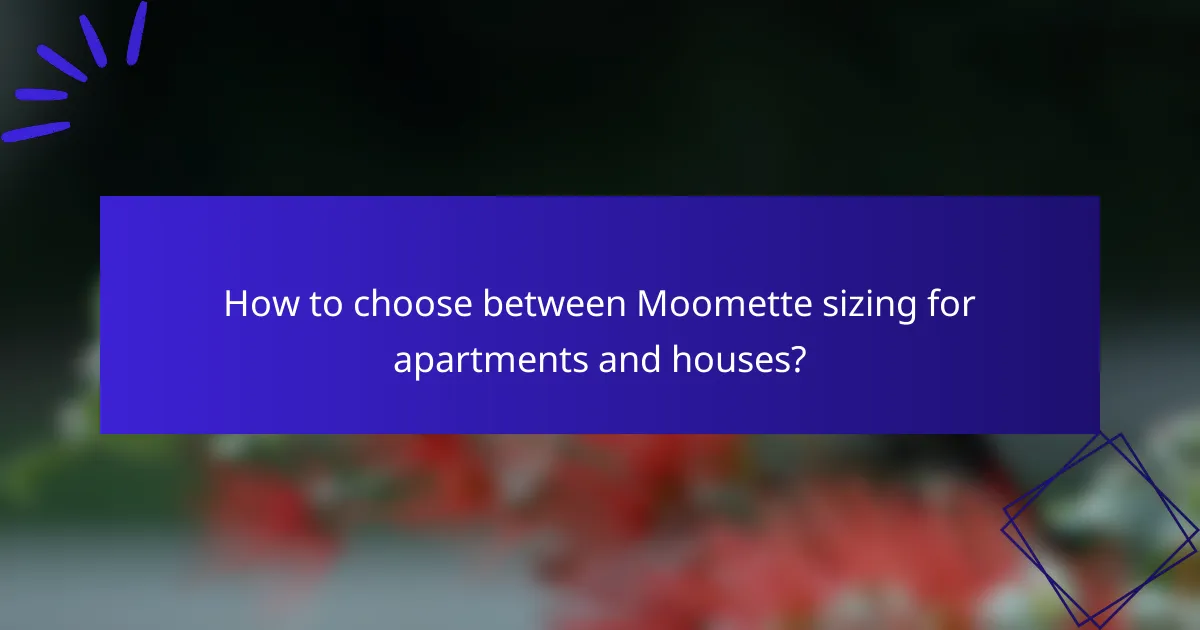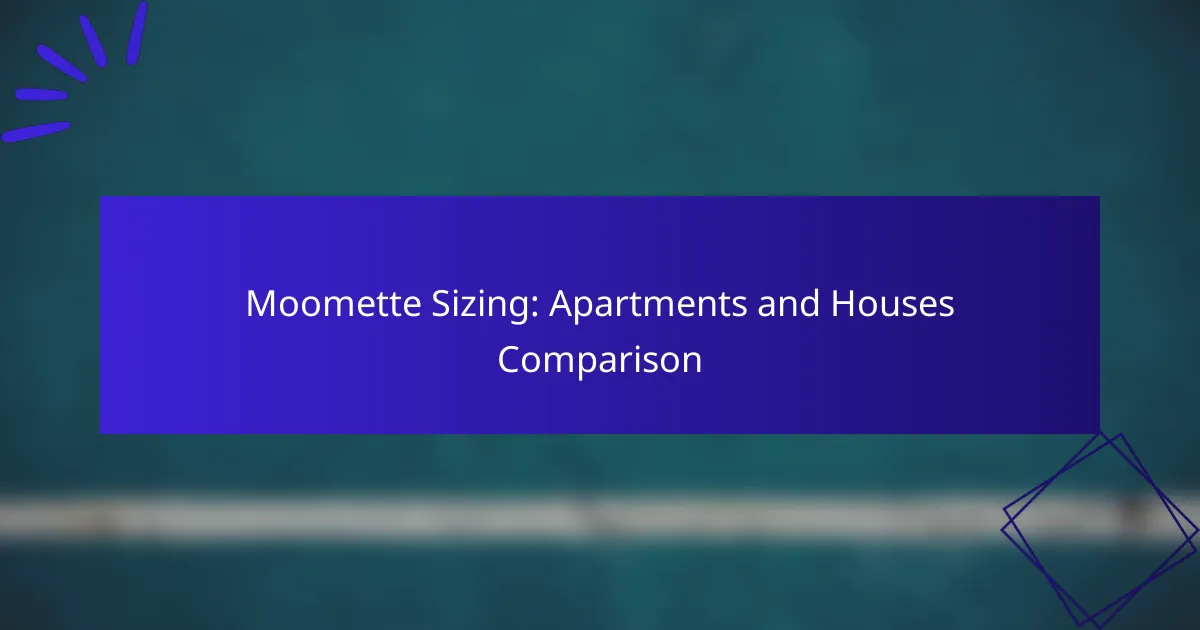Moomette sizing plays a crucial role in the comparison between apartments and houses, highlighting the distinct differences in layout and space utilization. While apartments benefit from compact dimensions that enhance functionality, houses provide larger areas that allow for greater customization and expansion. Understanding these differences can help residents optimize their living environments, whether in a cozy apartment or a spacious home.

How does Moomette sizing compare for apartments and houses?
Moomette sizing varies significantly between apartments and houses, primarily due to differences in layout and available space. Apartments typically have more compact dimensions, while houses offer larger areas for customization and expansion.
Apartment sizing guidelines
When considering Moomette sizing for apartments, it’s crucial to account for the limited square footage. Most apartments range from about 30 to 100 square meters, which necessitates efficient use of space. Focus on multi-functional furniture and vertical storage solutions to maximize usability.
Additionally, check local building regulations, as some areas may have specific guidelines regarding ceiling heights and room dimensions that can affect Moomette installations. Ensure that the design aligns with these standards to avoid compliance issues.
House sizing guidelines
In contrast, houses generally provide more generous dimensions, often exceeding 100 square meters. This additional space allows for more flexibility in Moomette sizing and design. Homeowners can incorporate larger units or even multiple Moomettes in different areas of the house.
Consider the layout of the house when planning Moomette installations. Open floor plans can enhance airflow and accessibility, while traditional layouts may require more strategic placement to optimize functionality.
Key differences in space utilization
The key difference in space utilization between apartments and houses lies in the overall available area and layout options. Apartments often require more creative solutions due to their compact nature, while houses can accommodate larger, more complex designs.
For example, in an apartment, a single Moomette might serve multiple purposes, such as a workspace and a relaxation area. In a house, you might have the luxury of dedicating separate spaces for each function, allowing for a more tailored approach to Moomette sizing.

What are the benefits of Moomette sizing for apartments?
Moomette sizing offers several advantages for apartment living, primarily by optimizing space and enhancing functionality. This approach allows residents to make the most of limited square footage, resulting in a more comfortable and efficient living environment.
Maximized living space
Moomette sizing focuses on utilizing every available inch of an apartment, which can significantly increase the perceived and actual living space. By incorporating multi-functional furniture and smart storage solutions, residents can create a more open and airy atmosphere.
For instance, using a fold-out sofa bed or a dining table that doubles as a workspace can free up valuable floor space when not in use. This strategy is particularly beneficial in urban areas where apartments tend to be smaller, often ranging from 30 to 70 square meters.
Improved layout efficiency
With Moomette sizing, the layout of an apartment is designed to enhance flow and accessibility. This means that rooms are arranged to minimize wasted space and ensure that each area serves a clear purpose, making daily activities more convenient.
For example, placing the kitchen adjacent to the living area can facilitate easier meal preparation and entertaining. Additionally, considering the placement of furniture and fixtures can help avoid clutter and create a more harmonious living environment, which is essential in compact spaces.

What are the benefits of Moomette sizing for houses?
Moomette sizing for houses offers improved space utilization and enhanced livability, making homes more comfortable and functional. This approach focuses on optimizing layout and dimensions to suit family needs and lifestyle preferences.
Enhanced comfort
With Moomette sizing, homes can be designed to maximize comfort by ensuring that rooms are appropriately scaled for their intended use. For instance, living areas can be spacious enough for gatherings, while bedrooms can provide a cozy retreat. This thoughtful sizing can lead to a more enjoyable living experience.
Consider incorporating features like natural light and ventilation into the design, as these elements can significantly enhance comfort. Aim for windows that allow ample sunlight and airflow, which can create a pleasant atmosphere throughout the home.
Better family dynamics
Moomette sizing can foster better family dynamics by creating spaces that encourage interaction and togetherness. Open floor plans and well-sized communal areas can facilitate family gatherings and activities, strengthening relationships among family members.
When planning a home, think about the flow between rooms and how family members will use the space. For example, a kitchen that opens up to a dining area can make meal preparation a shared experience, promoting collaboration and connection.

How to choose between Moomette sizing for apartments and houses?
Choosing the right Moomette sizing for apartments versus houses depends on your living situation and personal preferences. Consider factors such as lifestyle, family size, and budget to make an informed decision that suits your needs.
Consider lifestyle needs
Your lifestyle plays a crucial role in determining the appropriate Moomette sizing. For instance, if you frequently host guests or enjoy outdoor activities, a larger size may be beneficial. In contrast, if you prefer a minimalist lifestyle or have limited space, a smaller model could be more suitable.
Think about your daily routines and how much space you require for your activities. For example, a busy professional might prioritize a compact design that fits well in an apartment, while a family might need a larger unit for various household tasks.
Evaluate family size
Family size significantly influences the choice of Moomette sizing. A single individual or couple may find that a smaller unit meets their needs, while larger families will likely require more space for functionality. Generally, consider adding extra capacity for future growth or occasional guests.
As a guideline, a family of four might benefit from a mid-sized Moomette, while a household of six or more should look into larger options to ensure comfort and efficiency.
Assess budget constraints
Your budget is a key factor when selecting Moomette sizing for either apartments or houses. Prices can vary widely based on size and features, so it’s essential to determine how much you are willing to spend. Generally, larger units will come with higher costs, both in initial purchase and ongoing maintenance.
Consider setting a budget range that includes potential additional costs, such as installation and utility expenses. For example, if your budget is around $500 to $1,500, you may need to prioritize features that align with your lifestyle and family size to make the most of your investment.

What are the common misconceptions about Moomette sizing?
Many people mistakenly believe that Moomette sizing is straightforward and uniform across different types of living spaces. In reality, various factors influence sizing, including the type of dwelling, layout, and intended use.
Size equates to quality
A common misconception is that larger Moomette sizes automatically mean better quality. However, quality is determined by factors such as materials, design, and functionality rather than mere size. For instance, a smaller Moomette with high-quality finishes can outperform a larger, poorly constructed one.
When evaluating Moomette options, consider the overall design and how well it meets your needs. A well-designed smaller space can often provide a more comfortable and efficient living experience than a larger, less thoughtfully arranged one.
All apartments are the same
Another misconception is that all apartments offer similar Moomette sizing and configurations. In reality, apartments can vary significantly in layout, dimensions, and amenities, which affects how Moomette sizing is applied. For example, a studio apartment may have a different Moomette sizing requirement compared to a two-bedroom unit.
When choosing an apartment, assess the specific Moomette sizing in relation to the space’s layout and your lifestyle needs. This ensures that you select an apartment that not only fits your size requirements but also enhances your living experience.

What factors influence Moomette sizing decisions?
Moomette sizing decisions are primarily influenced by location preferences, market trends, and the specific needs of residents. Understanding these factors helps in making informed choices about apartment and house sizes that align with lifestyle and budget considerations.
Location preferences
Location plays a crucial role in Moomette sizing, as different areas offer varying amenities, accessibility, and lifestyle options. Urban centers may require smaller living spaces due to higher costs, while suburban or rural areas might provide larger homes at more affordable prices.
When selecting a location, consider proximity to work, schools, and recreational facilities. For example, a family might prioritize a larger home in a quieter suburb, while a young professional may opt for a compact apartment in a bustling city.
Market trends in urban areas
Market trends significantly affect Moomette sizing in urban areas, where demand for housing can drive prices and influence available options. In many cities, there is a growing trend towards smaller, more efficient living spaces as people seek affordability and convenience.
For instance, micro-apartments have gained popularity in metropolitan areas, catering to singles and couples who prioritize location over space. It’s essential to stay informed about local real estate trends, as these can impact not only pricing but also the types of properties available for rent or purchase.

How does Moomette sizing impact resale value?
Moomette sizing significantly influences the resale value of properties. Larger layouts typically attract higher prices due to increased demand for spacious living environments.
Market demand for spacious layouts
In today’s real estate market, spacious layouts are highly sought after. Buyers often prioritize open floor plans and larger square footage, which can lead to higher resale values. Properties with Moomette sizing that offers generous living areas tend to sell faster and at premium prices.
For instance, homes with three or more bedrooms and ample living space are generally more appealing to families, which can drive up demand. Conversely, smaller apartments may struggle to attract buyers, especially in competitive markets.
To maximize resale value, consider optimizing the layout of your Moomette-sized property. Focus on creating functional spaces that enhance the overall flow and usability, as this can significantly impact buyer interest and perceived value.
